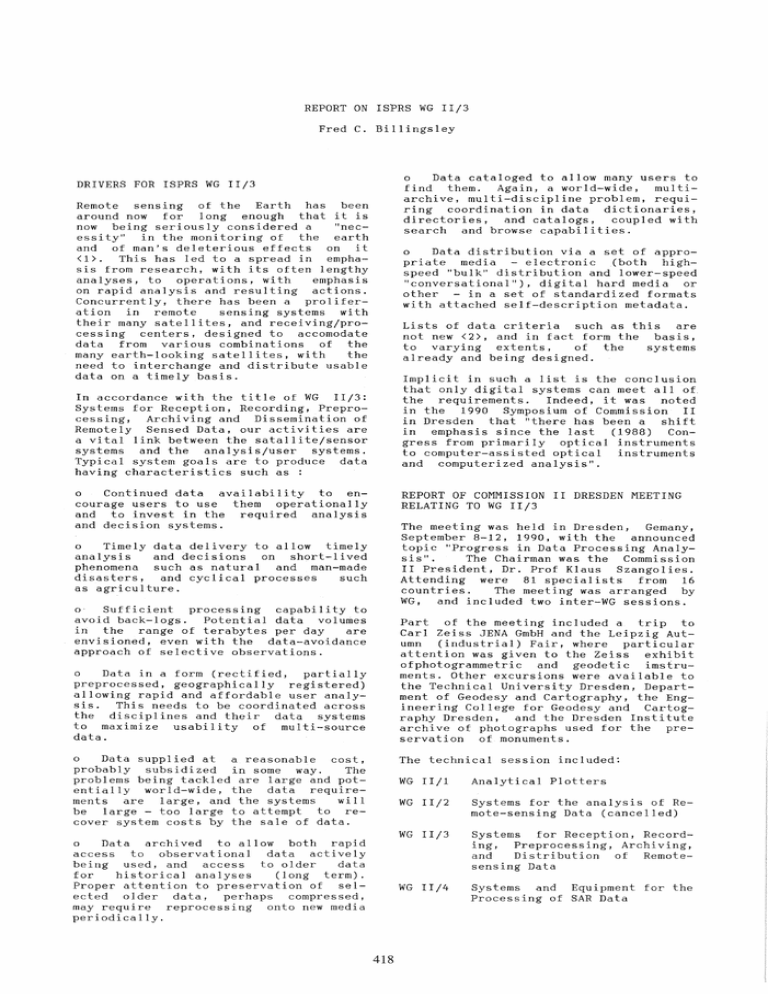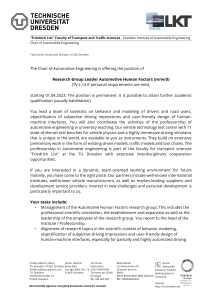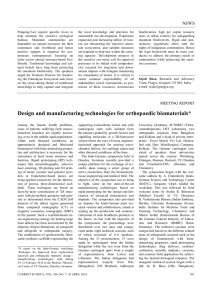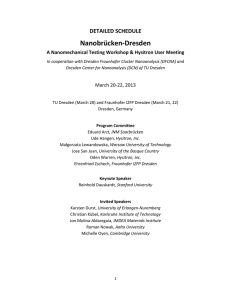REPORT ON ISFRS WG 11/3 Remote
advertisement

REPORT ON ISFRS WG 11/3 Fred C. Billingsley o Data cataloged to allow many users to find them. Again, a world-wide, multiarchive, multi-discipline problem, requiring coordination in data dictionaries, directories, and catalogs, coupled with search and browse capabilities. DRIVERS FOR ISPRS WG 11/3 Remote sensing of the Earth has been around now for long enough that it is now being seriously considered a "necessity" in the monitoring of the earth and of man's deleterious effects on it <1>. This has led to a spread in emphasis from research, with its often lengthy analyses, to operations, with emphasis on rapid analysis and resulting actions. Concurrently, there has been a proliferation in remote sensing systems with their many satellites, and receiving/processing centers, designed to accomodate data from various combinations of the many earth-looking satellites, with the need to interchange and distribute usable data on a timely basis. o Data distribution via a set of appropriate media - electronic (both highspeed "bulk" distribution and lower-speed "conversational"), digital hard media or other - in a set of standardized formats with attached self-description metadata. Lists of data criteria such as this are not new <2>, and in fact form the basis, to varying extents, of the systems already and being designed. Implicit in such a list is the conclusion that only digital systems can meet all of the requirements. Indeed, it was noted in the 1990 Symposium of Commission II in Dresden that "there has been a shift in emphasis since the last (1988) Congress from primarily optical instruments to computer-assisted optical instruments and computerized analysis", In accordance with the title of WG 11/3: Systems for Reception, Recording, Preprocessing, Archiving and Dissemination of Remotely Sensed Data, our activities are a vital link between the satallite/sensor systems and the analysis/user systems. Typical system goals are to produce data having characteristics such as : Continued data availability to eno courage users to use them operationally and to invest in the required analysis and decision systems. REPORT OF COMMISSION II DRESDEN MEETING RELATING TO WG 11/3 The meeting was held in Dresden, Gemany, September 8-12, 1990, with the announced topic "Progress in Data Processing Analysis". The Chairman was the Commission I I President, Dr. Prof Klaus Szangolies. Attending were 81 specialists from 16 countries. The meeting was arranged by WG, and included two inter-WG sessions. o Timely data delivery to allow timely analysis and decisions on short-lived phenomena such as natural and man-made disasters, and cyclical processes such as agriculture. o Sufficient processing capability to avoid back-logs. Potential data volu~es in the range of terabytes per day are envisioned, even with the data-avoidance approach of selective observations. Part of the meeting included a trip to Carl Zeiss JENA GmbH and the Leipzig Autumn (industrial) Fair, where particular attention was given to the Zeiss exhibit ofphotogrammetric and geodetic imstruments. Other excursions were available to the Technical University Dresden, Department of Geodesy and Cartography, the Engineering College for Geodesy and Cartography Dresden, and the Dresden Institute archive of photographs used for the preservation of monuments. o Data in a form (rectified, partially preprocessed, geographically registered) allowing rapid and affordable user analysis. This needs to be coordinated across the disciplines and their data systems to maximize usability of multi-source data. o Data supplied at a reasonable cost, probably subsidized in some way. The problems being tackled are large and potentially world-wide, the data requirements are large, and the systems will be large - too large to attempt to recover system costs by the sale of data. The technical session included: o Data archived to allow both rapid access to observational data actively being used, and access to older data for historical analyses (long term). Proper attention to preservation of selected older data, perhaps compressed, may require reprocessing onto new media periodically. 418 WG 11/1 Analytical Plotters WG 11/2 Systems for the analysis of Remote-sensing Data (cancelled) WG 11/3 Systems for Reception, Recording, Preprocessing, Archiving, and Distribution of Remotesensing Data WG 11/4 Systems and Equipment for the Processing of SAR Data WG 11/5 IC WG 1/11 Integrated Systems Photogrammetric All attendees at this session are invited to declare themselves as interested in membership in WG 11/3. This will enable them to participate and to keep up with activities. There will be an InterCongress symposium in 1994 at a location to be determined. Acquisition and use of Space Photographic Data for Map Production and Map Revision IC WG II/III Design and Algorithmic Aspects of Digital Photogrammetric Work Stations * CEOS Committee on Earth Observing Satellites (its Working Group on Data) A Proceedings volume, ISPRS Volume 28 Part 2. "Proceedings of the Sympos i urn Progress in Data Processing and Analysis" is available through the Presidency of the Chamber of Technology as Coding 7901/90, Box 1315, D-I086 Berlin ($50 US) . (I> IEEE Technology and Society Magazine, special issue on the International Space Year, Vol 11 #1, Spring 1992 AND NOW, THIS SESSION AND THE FUTURE This is not the place, nor is it the intent, to comprehensively discuss the issues involved in the design of such data systems. Rather, the purpose of the above listing of some data and data systems attributes is to relate the activities of WG 11/3 to the larger context of upcoming world-wide Earth Observation systems. (2) Billingsley, F.C., "Quo Vactis, Remote Sensing? , presented at the AIAA/AAS Bicentennial Symposium at the Air and Space Museum, Washington, D.C., Oct 1976. Some data system activities of note but not reported here are the European Space Agency data system for ERS~I, a CEOS* prototype international directory/catalog, CEOS assembly of global data sets and a pilot project for data set interchange, and a propos~d (by Japan) global networking system for EOS data. It has been the experience in large data systems that the time from design to operations is five years or more. This has been true even when prototypes of critical elements are planned. Given that satellites forming the galaxy of observations are already being put in place, the urgency of pursuing research, prototyping and building of the several data systems is apparent., In this session there are two papers dealing directly with some aspects of the NASA Earth Observation System Data and Information System (EOSDIS), part of the USA contribution to these ~orld-wide activities. Other areas of major interest reported on in this session are data compression and precision digital rectification and geographic location of image data, and the integration of several type of related data. Other related papers are presented in Poster Sessions. 419




